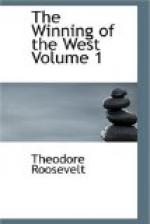The incomers soon recovered from the fright into which they had been thrown by the totally unexpected Indian attack; but the revengeful anger it excited in their breasts did not pass away. They came from a class already embittered by long warfare with their forest foes; they hoarded up their new wrongs in minds burdened with the memories of countless other outrages; and it is small wonder that repeated and often unprovoked treachery at last excited in them a fierce and indiscriminate hostility to all the red-skinned race. They had come to settle on ground to which, as far as it was possible, the Indian title had been by fair treaty extinguished. They ousted no Indians from the lands they took; they had had neither the chance nor the wish to themselves do wrong; in their eyes the attack on the part of the Indians was as wanton as it was cruel; and in all probability this view was correct, and their assailants were actuated more by the desire for scalps and plunder than by resentment at the occupation of hunting grounds to which they could have had little claim. In fact, throughout the history of the discovery and first settlement of Kentucky, the original outrages and murders were committed by the Indians on the whites, and not by the whites on the Indians. In the gloomy and ferocious wars that ensued, the wrongs done by each side were many and great.
Henderson’s company came into the beautiful Kentucky country in mid-April, when it looked its best: the trees were in leaf, the air heavy with fragrance, the snowy flowers of the dogwood whitened the woods, and the banks of the streams burned dull crimson with the wealth of red-bud blossoms. The travellers reached the fort that Boon was building on the 20th of the month, being welcomed to the protection of its wooden walls by a volley from twenty or thirty rifles. They at once set to with a will to finish it, and to make it a strong place of refuge against Indian attacks. It was a typical forted village, such as the frontiersmen built everywhere in the west and southwest during the years that they were pushing their way across the continent in the teeth of fierce and harassing warfare; in some features it was not unlike the hamlet-like “tun” in which the forefathers of these same pioneers dwelt, long centuries before, when they still lived by the sluggish waters of the lower Rhine, or had just crossed to the eastern coast of Britain.[15]
The fort was in shape a parallelogram, some two hundred and fifty feet long and half as wide. It was more completely finished than the majority of its kind, though little or no iron was used in its construction. At each corner was a two-storied loop-holed block-house to act as a bastion. The stout log-cabins were arranged in straight lines, so that their outer sides formed part of the wall, the spaces between them being filled with a high stockade, made of heavy squared timbers thrust upright into the ground, and bound together within by a horizontal stringer near the




